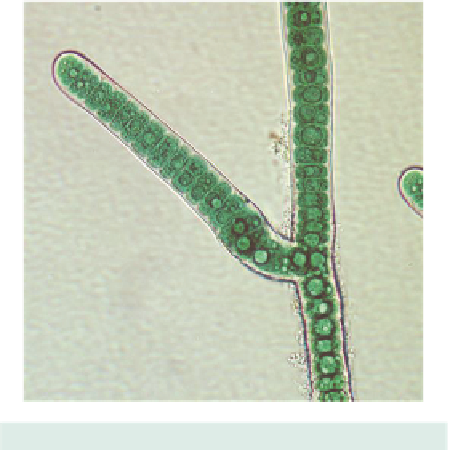Environmental Engineering Reference
In-Depth Information
(b) Chloroplast extending less than half way
round the cell. . . . .........
Klebsormidium
Filaments unbranched. Cells cylindrical
(may be slightly barrel-shaped) cells 5-
15 μm wide, 1-3 times long as wide. H-
shaped pieces sometimes present at cross
walls. The chloroplast consists of a parietal
band or plate extending part way round the
cell. A pyrenoid is usually present. Common
on damp soil and in temperate streams, can
occur on damp soil or wet rocks. Has been
found in acid, metal-rich waters. The fila-
ments fragment easily. For reliable identifi-
cation, it may be necessary to culture an envi-
ronmental sample. Chlorophyta. Plate VI.
50 μm
Figure 4.20
Stigonema.
Blue-green alga, showing
uniseriate main axis and side branch (true branching).
43
(4)
NB.
In the following section, the terms both
trichome
and
ilament
are used when speak-
ing about blue-green algae. The difference
between the two terms is defined as follows
(John
et al
., 2002):
species). Grows as a thin mat over stones,
rocks, damp soil or damp trees but can break
away and become free-floating. Cyanophyta.
Plate VI. Fig. 4.20.
A
ilament
is a number of cells united in one
or more rows to form a chain or thread. In the
case of blue-green algae, it refers to species
which have a sheath surrounding the cells.
A
trichome
is a linear arrangement of cells
arranged without a surrounding sheath.
44
(43) (a) False branching present . ...........
45
(b) False branching mostly absent (may
rarely be present in
Rivularia
but this genus
is easy to distinguish because of its tapering
trichomes). ...........................
46
(a) Filaments or trichomes without true
branching. False branching may be present
.....................................
44
45
(44) (a) False branches arise singly
.............................
Tolypothrix
(b) True branching present . ....
Stigonema
Stigonema
grows with branched trichomes
up to 50 μm wide, the main axis of which
may be multiseriate with the side branches
uniseriate. The branched mass is structured
enough to be called a colony (John
et al
.,
2002). Young cells at the branch tips can
be transformed into hormogonia. Occasional
heterocysts may be present. A irm mucilagi-
nous sheath is present which is often stained
yellowish-brown in colour. Cells may be
quadrate or cylindrical (depending upon
In
Tolypothrix
the trichomes show false
branching where the branches are single and
are often with a basal heterocyst. A brown-
ish (sometimes colourless) sheath is present.
Hormogonia may be produced at the ends.
Filaments 6-18 μm in diameter. Usually
attached or tangled amongst submerged veg-
etation but occasionally free-floating, often
in more calcareous unpolluted waters. Can
occur on damp rocks. Cyanophyta. Plate VI.
Fig. 4.21.

Search WWH ::

Custom Search